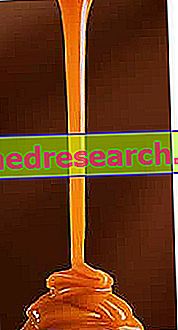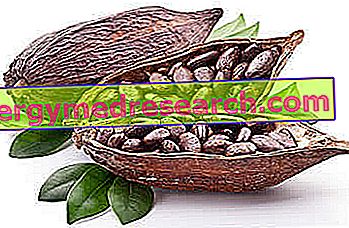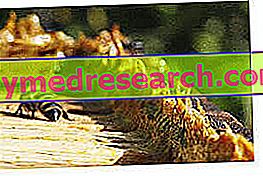Generality
Caramel is a sweet cooking preparation whose basic ingredient corresponds to the only energetic nutrient: sucrose (or table sugar, if you prefer).

From what has been said, it can be deduced that the caramel is a food with a very high percentage of carbohydrates, which implies an energy contribution to say the least supported; moreover, the various types of caramel always have a rather moderate or almost zero percentage of water, which varies depending on the type of caramel itself (as will be read below). These characteristics make the caramel a food with rather important nutritional contraindications, especially if contextualized in the diet of overweight subjects or those suffering from metabolic diseases.
Caramel is used in confectionery but its application in savory recipes is not so obsolete. It should also be noted that caramel is included in the list of legal food additives in Italy.
Production and types of pure caramel
The caramel is prepared by melting the sugar in copper or aluminum containers.
Depending on the type of caramel to be obtained, the recipe varies according to: presence of water, choice of basic raw material and cooking temperature. NB . Even in solid caramel it is useful to add a very small amount of water to the sugar before cooking; it is essential in order not to burn it early when the melting point is uniformly reached.
The consistency of the caramel can be solid or liquid and the color varies from deep yellow to dark brown, almost black.
Getting a solid caramel is a fairly simple procedure: simply place the sugar in the pan and bring it to a temperature high enough for melting (at least 160 ° C); once cooled, the caramel will crystallize again acquiring a compact and glassy consistency. On the contrary, if it were necessary to obtain a liquid caramel, once the melting threshold is reached, it is determined to "stop" the sugar cooking by adding a quantity of boiling liquid (water or other, based on the final product) equal to the weight of the material first processed (ratio 1: 1).
At the same time, the color of the caramel varies according to the type of ingredient chosen and the intensity of cooking. Among the types of raw material that can "caramelize", in decreasing chromatic order, we list: glucose (which produces a darker caramel ), sucrose, fructose and honey (which produces a lighter caramel). With the same ingredient, caramel browning is mainly determined by the triggering of the Maillard reaction (non-enzymatic and obtained by temperature); this reaction is directly proportional to the increase and to the cooking time, therefore, more intensely and for a long time the caramel is cooked, the darker it will become. NB . The sucrose browning temperature is about 165 ° C.
It is however necessary to specify that the Maillard reaction is NOT uncomplicated; in addition to the chromatic variation, it greatly affects the olfactory and gustatory parameters of the caramel, giving first a pleasant hint of cooked sugar and then (gradually) a very bad note of "burnt" (bitter and pungent). As if this were not enough, the excessive triggering of the Maillard reaction inexorably compromises the wholesomeness of the caramel which, proportionally to time and temperature, gives rise to molecules of type harmful to the organism. The Maillard reaction for sucrose caramel must occur at a temperature between 165 and 177 ° C. NB . To obtain a good caramel, both solid and liquid, it is possible to use the laser gun for instantaneous thermal detection.
Obviously, by changing the raw material used, it is not possible to standardize the time and intensity of cooking. Having already specified the chemical-physical differences existing between the various types of sugar and honey, we remind you that the cooking time for solid caramel also varies based on the amount of water initially added to prevent sugar burning. The more it is used, the longer it will be necessary to cook the caramel to dehydrate it (at an optimal temperature, the process is clearly visible for the release of water vapor).
It is also advisable to make a final statement regarding the honey caramel. This is obtained always and only in liquid form, since the solid one would require excessively high processing times due to the high concentration of water in the raw material used.
Caramel sauce here's how to do it - video recipe
Caramel Sauce
X Problems with video playback? Reload from YouTube Go to Video Page Go to Video Recipes Section Watch the video on youtubeLiquid flavored caramel: as anticipated, the caramel, to become liquid, needs the addition at the end of cooking of another fluid and hot ingredient in a 1: 1 ratio.
Nutritional composition per 100g of Caramel - Reference values of the Food Composition Tables - INRAN | ||||||||||||||||||||||||||||||||||||||||||||||||||||||||||||||||||||||||||||||||||||||||||||||||||||||||||||||||||||
 | ||||||||||||||||||||||||||||||||||||||||||||||||||||||||||||||||||||||||||||||||||||||||||||||||||||||||||||||||||||
Nutritional values (per 100 g of edible portion)
| ||||||||||||||||||||||||||||||||||||||||||||||||||||||||||||||||||||||||||||||||||||||||||||||||||||||||||||||||||||
This can be pure or compound; some examples are: milk, cream or a mixture between them for the production of toffee or mou (obtainable also in solid form for complete dehydration), balsamic vinegar, (obtainable using balsamic vinegar), warm orange juice etc.
Gastronomic uses
Caramel is a pastry base also used in salted / sweet-and-sour preparations. In pastry, caramel is used as a liquid to accompany some spoon desserts, cakes, ice creams of various kinds, etc., while hard caramel is mainly crunchy nuts, cake toppings, decorative threads, sweets, etc. In the salty kitchen instead, the caramel has become a garnish and complement for various cold preparations, for example terrines of fatty liver of goose, other paté, warm salads (with white meat and dried and / or fresh fruit), stuffed pasta etc.
Moreover, the caramel is formed spontaneously by "glazing" of some roasts in which, often combined with citrus peel, it helps to polish and flavor the surface of the dish.
Nutritional properties
Caramel is a highly energetic sweet food that does not lend itself to the diet of the overweight person. It has a very high index and glycemic load, which is why it is totally unsuitable for the type 2 diabetic's diet.
Caramel has a harmful action on the teeth because it significantly promotes the formation of caries; moreover, the solid one is difficult to chew and can cause teeth or dental prosthesis to break. The CORRECT and SUFFICIENT caramel Maillard reaction does not constitute a health risk, even if an abuse of the food or excessive heat treatment could increase the risk linked to the action of certain unwanted molecules.
Caramel is also a preservative and coloring food; little used for a preservative purpose (where the syrup is king), it is one of the most used additive ingredients in the food sector (abbreviation E150). It gives, for example, the typical cola drink color.



